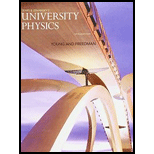
BIO QUENCHING AN MRI MAGNET. Magnets carrying very large currents are used to produce the uniform, large-magnitude magnetic fields that are required for magnetic resonance imaging (MRI). A typical MRI magnet may be a solenoid that is 2.0 m long and 1.0 m in diameter, has a self-inductance of 4.4 H, and carries a current of 750 A. A normal wire carrying that much current would dissipate a great deal of electrical power as heat, so most MRI magnets are made with coils of superconducting wire cooled by liquid helium at a temperature just under its boiling point (4.2 K). After a current is established in the wire, the power supply is disconnected and the magnet leads are shorted together through a piece of superconductor so that the current flows without resistance as long as the liquid helium keeps the magnet cold.
Under rare circumstances, a small segment of the magnet’s wire may lose its superconducting properties and develop resistance. In this segment, electrical energy is converted to thermal energy, which can boil off some of the liquid helium. More of the wire then warms up and loses its superconducting properties, thus dissipating even more energy as heat. Because the latent heat of vaporization of liquid helium is quite low (20.9 kJ/kg), once the wire begins to warm up, all of the liquid helium may boil off rapidly. This event, called a quench, can damage the magnet. Also, a
30.72 How many turns does this typical MRI magnet have? (a) 1100; (b) 3000; (c) 4000; (d) 22,000.
Want to see the full answer?
Check out a sample textbook solution
Chapter 30 Solutions
University Physics (14th Edition)
Additional Science Textbook Solutions
Campbell Essential Biology with Physiology (5th Edition)
Biology: Life on Earth with Physiology (11th Edition)
Laboratory Experiments in Microbiology (12th Edition) (What's New in Microbiology)
Organic Chemistry (8th Edition)
Chemistry: An Introduction to General, Organic, and Biological Chemistry (13th Edition)
Human Anatomy & Physiology (2nd Edition)

 College PhysicsPhysicsISBN:9781938168000Author:Paul Peter Urone, Roger HinrichsPublisher:OpenStax College
College PhysicsPhysicsISBN:9781938168000Author:Paul Peter Urone, Roger HinrichsPublisher:OpenStax College Physics for Scientists and Engineers: Foundations...PhysicsISBN:9781133939146Author:Katz, Debora M.Publisher:Cengage Learning
Physics for Scientists and Engineers: Foundations...PhysicsISBN:9781133939146Author:Katz, Debora M.Publisher:Cengage Learning Principles of Physics: A Calculus-Based TextPhysicsISBN:9781133104261Author:Raymond A. Serway, John W. JewettPublisher:Cengage Learning
Principles of Physics: A Calculus-Based TextPhysicsISBN:9781133104261Author:Raymond A. Serway, John W. JewettPublisher:Cengage Learning Physics for Scientists and EngineersPhysicsISBN:9781337553278Author:Raymond A. Serway, John W. JewettPublisher:Cengage Learning
Physics for Scientists and EngineersPhysicsISBN:9781337553278Author:Raymond A. Serway, John W. JewettPublisher:Cengage Learning Physics for Scientists and Engineers with Modern ...PhysicsISBN:9781337553292Author:Raymond A. Serway, John W. JewettPublisher:Cengage Learning
Physics for Scientists and Engineers with Modern ...PhysicsISBN:9781337553292Author:Raymond A. Serway, John W. JewettPublisher:Cengage Learning





